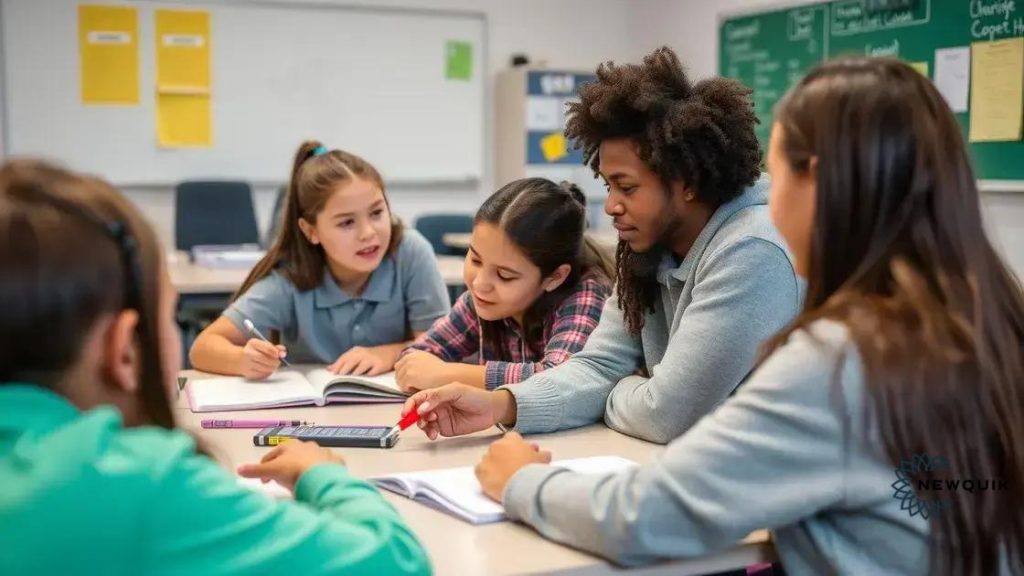Neuroeducation: Unlocking brain power for better learning

Anúncios
Neuroeducation combines neuroscience, psychology, and education to enhance learning and teaching methods by providing tailored strategies that improve student engagement, retention, and emotional support.
Neuroeducation merges brain science with learning. Are you curious to know how this approach enhances educational experiences for both students and educators? Join us as we explore this fascinating field.
Anúncios
Understanding neuroeducation in modern learning
Understanding neuroeducation is crucial in today’s learning environment. This interdisciplinary approach combines neuroscience, psychology, and education to enhance how we teach and learn.
At its core, neuroeducation seeks to apply knowledge from brain science to improve educational practices. By understanding how the brain processes information, educators can develop strategies that cater to the diverse learning needs of students.
The Brain and Learning
The brain is an intricate organ responsible for all our thoughts and actions. Research in neuroeducation reveals that specific learning techniques can positively influence brain growth and cognitive development.
Anúncios
Key Principles of Neuroeducation
- Understanding how emotions impact learning.
- Recognizing that memory is influenced by context.
- Utilizing repetition and practice to strengthen neural connections.
- Implementing multisensory learning experiences.
It’s fascinating how neuroeducation emphasizes the role of emotions in learning. Positive emotional experiences can enhance retention and understanding, while negative emotions can hinder them. This insight encourages educators to create a supportive and engaging classroom atmosphere.
Additionally, neuroeducation highlights the connectivity in learning. Information presented in context allows students to better understand and remember new concepts. Hence, integrating practical applications and real-life examples into lessons is vital.
Benefits of Neuroeducation
Applying the principles of neuroeducation not only benefits students but also aids teachers. When educators adapt their strategies based on how the brain learns, they often see improved engagement and results.
- Enhanced student engagement.
- Improved academic performance.
- Tailored teaching methods for diverse learners.
- Greater teacher satisfaction.
In conclusion, understanding neuroeducation in modern learning is essential for optimizing educational outcomes. By leveraging insights from brain science, educators can create learning environments that foster growth and success.
The role of brain science in education
The role of brain science in education is a vital aspect of understanding how students learn. Insights from neuroscience can transform teaching methods, making them more effective.
One key area is how neuroplasticity affects learning. This concept suggests that the brain can change and adapt throughout a person’s life. Therefore, teaching techniques that embrace this adaptability can enhance learning and retention.
Understanding Memory
Memory plays a crucial part in education. Research shows that memories are formed via connections between neurons. By using techniques that strengthen these connections, educators can help students retain information better.
- Active learning promotes better retention.
- Visual aids can enhance memory formation.
- Spaced repetition helps reinforce learning over time.
Additionally, brain science tells us about the role of emotions in education. Positive emotional experiences can lead to improved learning outcomes. When students are happy and engaged, they are more likely to absorb new material. This understanding encourages teachers to foster a positive classroom environment.
Strategies Influenced by Brain Science
Effective teaching strategies informed by brain science include differentiated instruction and personalized learning. Recognizing that each student has unique learning needs allows educators to tailor their methods.
- Using technology to create personalized learning paths.
- Incorporating cooperative learning to build social skills.
- Engaging students with hands-on activities.
Incorporating findings from brain science not only enhances student learning but also empowers teachers. By understanding how the brain works, educators can develop techniques that cater to both teaching goals and student needs.
Practical strategies for implementing neuroeducation

Practical strategies for implementing neuroeducation can significantly enhance the learning experience. Educators who understand brain science can create environments that foster student growth and engagement.
One effective strategy is to incorporate multisensory learning. This approach engages multiple senses – sight, sound, touch – which enhances understanding and memory. When students interact with materials in various ways, they are more likely to retain information.
Techniques for Multisensory Learning
Employing techniques like visual aids, hands-on activities, and interactive discussions encourages engagement. For instance, using diagrams or videos in presentations can help students visualize complex concepts.
- Using charts and graphs to present data.
- Incorporating interactive technology such as smartboards.
- Providing physical activities related to the content.
Another important aspect is differentiated instruction, which involves tailoring lessons to meet the varying needs of students. By recognizing that not every learner absorbs information in the same way, teachers can adapt their methods.
Implementing Differentiated Instruction
To implement this strategy effectively, teachers can use flexible grouping, varied instructional methods, and personalized assignments. This creates a more inclusive environment and helps every student succeed.
- Grouping students by ability or interest.
- Offering choices in learning activities.
- Providing additional support for struggling learners.
Using formative assessment is also a practical strategy. Through ongoing assessments, teachers can gain insights into student understanding and adjust their teaching accordingly. By providing timely feedback, educators ensure that students stay on track.
Incorporating neuroeducation principles in classrooms creates a dynamic learning atmosphere. When students feel engaged and understood, their motivation and performance increase. Taking these practical steps can lead to positive outcomes for both students and teachers.
Benefits of neuroeducation for students and teachers
The benefits of neuroeducation for both students and teachers are profound. Understanding how the brain works can transform traditional educational methods into more effective learning experiences.
For students, one major advantage is improved engagement. When teachers apply neuroscience principles, lessons become more relatable and exciting. This increased interest directly enhances motivation and participation in class activities.
Enhancing Learning Outcomes
Another key benefit is the potential for better learning outcomes. By using techniques based on brain science, educators can create strategies that cater to various learning styles, ensuring all students grasp essential concepts.
- Tailored instruction addresses individual needs.
- Active learning approaches boost retention.
- Positive emotional connections enhance memory.
Teachers also experience significant advantages from applying neuroeducation. Gaining insights into how students learn allows them to refine their teaching methods. This leads to a more productive classroom filled with active learners.
Teacher Satisfaction
Moreover, as educators witness their students succeed, they often experience increased job satisfaction. When students thrive, it reflects positively on the educator, fostering a sense of accomplishment.
- Fostering supportive classroom environments.
- Encouraging collaboration among peers.
- Enhancing professional skills through ongoing learning.
Ultimately, neuroeducation offers a collaborative approach where both students and teachers grow. Adopting these practices leads to a healthy learning community, where knowledge is actively shared and developed. The positive effects resonate throughout the educational environment, making the journey of learning enriching for everyone involved.
Future trends in neuroeducation
Future trends in neuroeducation are set to reshape how we approach teaching and learning. As research in neuroscience advances, new insights will significantly influence educational practices.
One notable trend is the increased use of technology in the classroom. Virtual reality (VR) and augmented reality (AR) are becoming powerful tools for enhancing learning experiences. These technologies can create immersive environments where students actively engage with content.
The Rise of Personalized Learning
Another expected trend is the growth of personalized learning. Education will move towards tailoring learning experiences based on individual student needs, learning styles, and interests. This approach not only helps students learn at their own pace but also keeps them motivated and engaged.
- Adaptive learning technologies will adjust content in real-time.
- Learning platforms will offer curated resources matching students’ preferences.
- Data-driven insights will guide educators in improving instruction.
Additionally, a stronger emphasis on social-emotional learning (SEL) will influence future educational practices. Addressing students’ emotional and social needs is essential for their overall development. Educators will be trained in strategies that promote mental wellness and resilience in the classroom.
Cross-disciplinary Approaches
Cross-disciplinary teaching methods are also on the rise. Combining various subjects can deepen learning and enhance critical thinking. For instance, integrating science and art can lead to more creative problem-solving.
- Developing projects that blend different disciplines.
- Encouraging collaboration among teachers of various subjects.
- Creating real-world applications that connect multiple fields.
As awareness of the brain’s role in learning grows, future trends in neuroeducation will focus on creating supportive, responsive environments that cater to all students. By embracing these trends, education can become a more inclusive and enriching experience for everyone.
FAQ – Frequently Asked Questions about Neuroeducation
What is neuroeducation?
Neuroeducation is an interdisciplinary approach that combines neuroscience, psychology, and education to enhance teaching and learning methods.
How does technology impact neuroeducation?
Technology enriches neuroeducation by providing interactive tools like virtual reality and personalized learning platforms that cater to individual student needs.
What are some benefits of neuroeducation for students?
Students benefit from improved engagement, better learning outcomes, and emotional support, leading to a more effective and enjoyable learning experience.
How can teachers implement neuroeducation strategies?
Teachers can implement neuroeducation strategies by incorporating multisensory learning, differentiated instruction, and ongoing assessment to tailor their teaching to each student’s needs.





